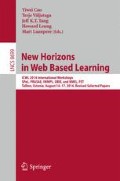Abstract
In the current paper we propose a framework for designing interactive content to make future e-books more dynamic. The problem with typical e-books today is that they seem to have a lack of interactivity. Considering the rapid advancement of digital technology there are many opportunities to change this situation. We focus on using the multimedia authoring tool Scratch as an option to create interactive content. The Scratch platform is valuable because content can be easily created, shared, embedded in websites and even possibly embedded in future e-books. Thus it opens up a possibility for making e-books more interactive and dynamic. Scratch by its very nature also promotes the constructivist pedagogy of learning by design. The framework we propose for designing interactive Scratch content was derived from creating a specific Scratch model to teach biology content. However, the framework is a promising start to producing interactive content that can apply potentially to any subject.
Access this chapter
Tax calculation will be finalised at checkout
Purchases are for personal use only
References
Wieman, C.E., Adams, W.K., Perkins, K.K.: PhET: simulations that enhance learning. Science 322, 682–683 (2008). doi:10.2307/20145153
De Jong, T., Lazonder, A., van Joolingen, W., Wasson, B., Vold, V., Hovardas, T., Giemza, A.: Using scenarios to design complex technology-enhanced learning environments. Educ. Technol. Res. Dev. 60, 883–901 (2012). doi:10.1007/s11423-012-9258-1
Mäeots, M., Pedaste, M., Sarapuu, T.: Developing students’ transformative and regulative inquiry skills in a computer-based simulation. In: Paper presented at the 8th IASTED International Conference on Web-Based Education, Phuket, Thailand, 16–18 March 2009
Huang, Y., Liang, T., Su, Y., Chen, N.: Empowering personalized learning with an interactive e-book learning system for elementary school students. Educ. Technol. Res. Dev. 60, 703–722 (2012). doi:10.1007/s11423-012-9237-6
Kuhl, T., Scheiter, K., Gerjets, P., Gemballa, S.: Can differences in learning strategies explain the benefits of learning from static and dynamic visualizations? Comput. Educ. 56, 176–187 (2011)
Renkl, A., Atkinson, R.K.: Interactive learning environments: contemporary issues and trends. An introduction to the special issue. Educ. Psychol. Rev. 19, 235–238 (2007). doi:10.1007/s10648-007-9052-5
Prince, M.J., Felder, R.M.: Inductive teaching and learning methods: definitions, comparisons, and research bases. J. Eng. Educ. 95, 123–138 (2006)
Vreman-de Olde, C., de Jong, T., Gijlers, H.: Learning by designing instruction in the context of simulation-based inquiry learning. J. Educ. Technol. Soc. 16, 47–58 (2013)
Bollen, L., van Joolingen, W.: SimSketch: multiagent simulations based on learner-created sketches for early science education. IEEE Trans. Learn. Technol. 6, 208–216 (2013). doi:10.1109/TLT.2013.9
Maloney, J., Resnick, M., Rusk, N., Silverman, B., Eastmond, E.: The Scratch programming language and environment. Trans. Comput. Educ. 10, 1–15 (2010). doi:10.1145/1868358.1868363
López-Ortega, O.: Computer-assisted creativity: emulation of cognitive processes on a multi-agent system. Expert Syst. Appl. 40, 3459–3470 (2013). doi:10.1016/j.eswa.2012.12.054
Bravo, C., van Joolingen, W., de Jong, T.: Modeling and simulation in inquiry learning: checking solutions and giving intelligent advice. Simulation 82, 769–784 (2006). doi:10.1177/0037549706074190
Lee, Y.: Scratch: Multimedia programming environment for young gifted learners. Gifted Child Today 34, 26–31 (2011)
Scaffidi, C., Chambers, C.: Skill progression demonstrated by users in the Scratch animation environment. Int. J. Hum.-Comput. Interact. 28, 383–398 (2012). doi:10.1080/10447318.2011.595621
Siiman, L.A., Pedaste, M., Tõnisson, E., Sell, R., Jaakkola, T., Alimisis, D.: A review of interventions to recruit and retain ICT students. Int. J. Mod. Educ. Comput. Sci. 28, 383–398 (2014). doi:10.1080/10447318.2011.595621
Maloney, J.J., Burd, L.L., Kafai, Y.Y., Rusk, N.N., Silverman, B.B., Resnick, M.M.: Scratch: a sneak preview [education]. In: Proceedings Second International Conference on Creating, Connecting and Collaborating Through Computing, p. 104 (2004). doi:10.1109/C5.2004.1314376
Estonian National Curriculum for Upper Secondary Schools. Appendix 4: Natural Science, p. 12 (2011). http://www.hm.ee/index.php?popup=download&id=11228
Acknowledgements
The Scratch models used in this research were produced in the context of a project Biodigi (http://www.biodigi.edu.ee/), financed by the European Social Fund. We would like to thank Meelis Brikker who created all drawings for the models.
Author information
Authors and Affiliations
Corresponding author
Editor information
Editors and Affiliations
Rights and permissions
Copyright information
© 2014 Springer International Publishing Switzerland
About this paper
Cite this paper
Mäeots, M., Siiman, L., Pedaste, M. (2014). Designing Interactive Scratch Content for Future E-books. In: Cao, Y., Väljataga, T., Tang, J., Leung, H., Laanpere, M. (eds) New Horizons in Web Based Learning. ICWL 2014. Lecture Notes in Computer Science(), vol 8699. Springer, Cham. https://doi.org/10.1007/978-3-319-13296-9_26
Download citation
DOI: https://doi.org/10.1007/978-3-319-13296-9_26
Published:
Publisher Name: Springer, Cham
Print ISBN: 978-3-319-13295-2
Online ISBN: 978-3-319-13296-9
eBook Packages: Computer ScienceComputer Science (R0)

